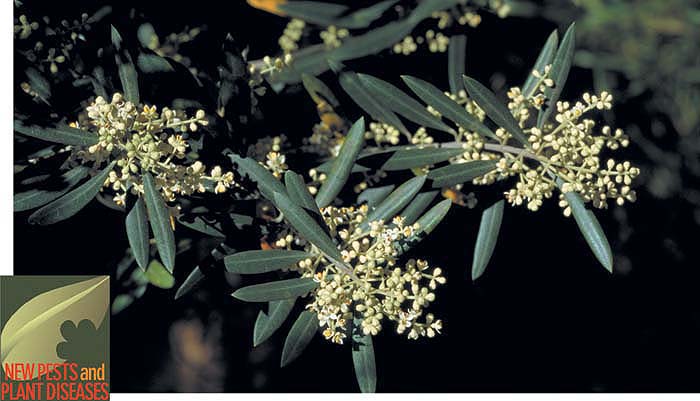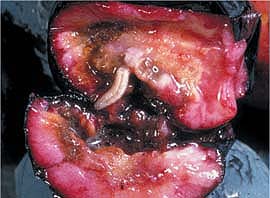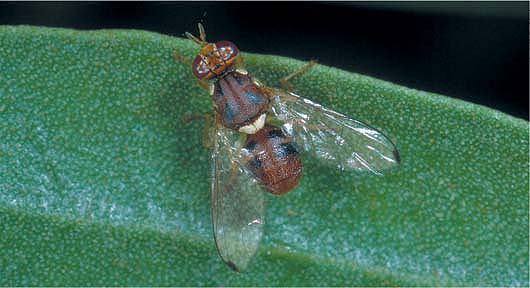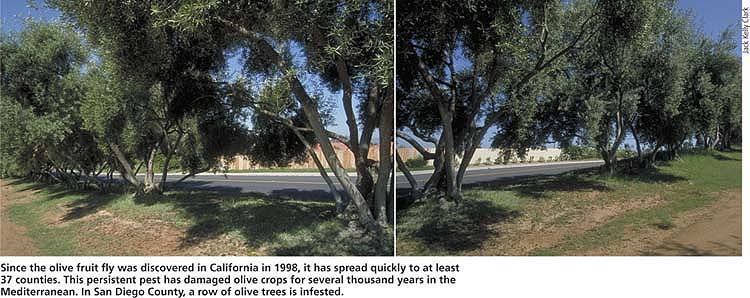All Issues
Prospects for integrated control of olive fruit fly are promising in California
Publication Information
California Agriculture 57(1):28-32. https://doi.org/10.3733/ca.v057n01p28
Published January 01, 2003
PDF | Citation | Permissions
Abstract
The recent invasion of California by the olive fruit fly has the potential to devastate commercial olive production throughout the state. Fortunately, much is known about this pest in Europe, and prospects for olive fruit fly control in Calif-ornia are good. Effective manage-ment is likely to result from careful monitoring and properly timed chemical control. Suppression of olive fruit fly populations on ornamental and residential olive trees using biological control may also contribute to overall control.
Full text
The olive fruit fly was first observed in California in October 1998, when a single female fly was captured in a McPhail trap in west Los Angeles. Over the next 2 months, 126 olive fruit flies were trapped in Los Angeles County. Malathion was applied in and around the capture sites, but by fall 1999 the fly had spread to seven new California counties, including Tulare County in the southern Central Valley. By 2001, the olive fruit fly had spread north of the San Francisco Bay along the coast and to olive production areas in Glenn, Butte and Tehama counties in the northern Central Valley. It now occurs in at least 37 counties in California.
The invasion of California by the olive fruit fly has been both rapid and troublesome for the state's olive industry. In 2001, California growers produced 99% of the commercial olives grown in the United States, 134,000 tons of olives on 36,000 acres for a total value of $90 million (USDA 2002). The olive fruit fly poses a serious economic threat to both table olive and olive oil production in California. In the Mediterranean region, it has been one of the most devastating olive pests for more than 2000 years. Infestation of olive fruit by the larvae causes premature fruit drop and reduces fruit quality for both table olive and olive oil production (Michelakis and Neuenschwander 1983). In table olives, the presence of a few larvae can lead to rejection of an entire crop. Some infestation can be tolerated in olive oil production. However, the presence of larvae and associated microorganisms raises oil acidity and thereby reduces the quality of the oil. Untreated, olive fruit fly may infest more than 90% of olive fruit (Sharaf 1980; Kapatos and Fletcher 1984).
California's olive industry, which produces table olives and oil, is threatened by the olive fruit fly. A combination of biological and chemical controls may be necessary to achieve effective control.
Biology, life cycle and population
The olive fruit fly, Bactrocera oleae (Gmelin), belongs to the Tephritidae family of flies, which contains many notorious pests. Olive fruit flies are distinguished from many other tephritid fruit fly species by black spots on the wingtips and the lack of wing banding seen on other tephritid species, such as the apple maggot, walnut husk fly and Mediterranean fruit fly. An adult olive fruit fly is about the size of a housefly, approximately 5 millimeters or three-sixteenths-inch long. Females can be distinguished from males by the ovipositor, a pointed structure at the end of the female's abdomen. Females use the ovipositor to pierce olive fruit and lay eggs just under the skin. Usually, only one egg is laid per fruit, but multiple eggs may be laid in varieties that produce large fruit. Large-fruited varieties are, in fact, preferred over smaller-fruited varieties for egg laying. Under laboratory conditions, an individual female olive fruit fly may lay 10 to 40 eggs per day and a few hundred eggs in her lifetime (Tzanakakis 1989).
The main host plant of the olive fruit fly is the cultivated olive, Olea europea L., though other trees in the genus Olea may also be attacked. The most detailed information about olive fruit fly population ecology comes from a series of studies in an unsprayed olive grove in Corfu, Greece (Fletcher et al. 1978; Fletcher and Kapatos 1981; Kapatos and Fletcher 1984). Olive fruit fly dynamics are likely to be similar in California, although this remains to be determined. Adult flies first emerge in the spring (March to May). This generation attacks olives remaining on the tree from the previous season. During early summer when temperatures are high, days are long and few mature fruit remain on the trees, adult female olive fruit flies enter a state of reproductive diapause in which they have few or no mature eggs (Fletcher et al. 1978). This period is thought to be a time of adult dispersal. In Corfu, Greece, marked females dispersed an average of 440 feet per day during early summer, while males averaged 340 feet (Fletcher and Kapatos 1981).
Olive fruit fly females lay their eggs under the skin of fruit. The larva, above, infest mature olives with brown internal decay, causing premature fruit drop and potentially contaminating entire crops.
As the new crop of olives develops over the summer, female flies “break” reproductive diapause, produce eggs and become attracted to olive fruit. They lay eggs in the ripening, susceptible olive fruit starting in July, when the pits begin to harden. Multiple generations of the fly may occur over the ensuing summer and fall. Larvae produced during the summer and early fall pupate in the fruit and emerge later in the season. Larvae produced during the late fall pupate in the soil, where they spend the winter. Although the olive fruit fly does not have a true diapause, development is sufficiently slowed during the winter, that pupae produced in late fall do not emerge until the following spring. Olive fruit flies also overwinter as adults and to a lesser extent as eggs and larvae in unharvested fruit (Kapatos and Fletcher 1984).
The phenology of the olive fruit fly seems to be influenced by weather. Hot and dry summer conditions may reduce the buildup of populations on the new crop. During a cool summer in Corfu, Greece, for example, the number of larvae peaked at about 11,000 per tree in mid-August and then peaked again in late September at 18,000 per tree (Kapatos and Fletcher 1984). In the following year the summer was considerably hotter, and after an early peak of about 8,000 larvae per tree in late July, fewer than 4,000 larvae per tree were observed for the remainder of the year. This observation may have reflected that egg and larval fruit flies experience high mortality during hot, dry weather (Kapatos and Fletcher 1984). There may have been an effect of reproductive diapause, which may be prolonged under hot and dry conditions even when ripe olive fruit are present (Fletcher et al. 1978). We might therefore expect dramatic differences in population dynamics in the various olive production areas in California, such as in cool, coastal San Luis Obispo County versus relatively hot, inland Tulare County. Such phenological differences are likely to have important implications for control, but have not yet been investigated in California.
Monitoring and chemical control
Adult olive fruit fly populations are typically monitored using yellow sticky traps baited with sex pheromone and/or ammonium bicarbonate. Sex pheromone is attractive to male flies whereas ammonium bicarbonate is primarily attractive to females. Female fruit flies need protein for egg production and are attracted to ammonia, a volatile compound associated with protein decomposition. Both sexes are attracted to the trap's yellow color. Trap catches may vary in response to numerous variables, including temperature, humidity, physiological status of the fly and, of course, population size (Economopoulos 1979). Nevertheless, monitoring populations using sticky traps can be useful in timing insecticide applications. Such practice is widely used in Europe, where insecticide applications are made on the basis of threshold trap counts.
In Europe, the olive fruit fly is largely controlled using full cover sprays or bait sprays containing organophosphate insecticides, either dimethoate or fenthion (P. Vergoulas, personal communication). One or more cover sprays may be applied during a season. Because of different preharvest interval requirements, fenthion is applied early in the season and dimethoate later. Bait sprays are typically applied repeatedly over the season, with the number of applications depending on location, trap counts and whether the fruit is intended for oil or table olives. In cooler areas (such as Crete and Croatia), seven insecticidebait applications are made per year versus only two to three applications in hot, dry locations (such as central Greece and Spain; P. Vergoulas, personal communication). Bait sprays capitalize on fruit flies’ attraction to protein, a major component of the bait. The flies feed on the insecticide in the bait and die.
Since the olive fruit fly was discovered in California in 1998, it has spread quickly to at least 37 counties. This persistent pest has damaged olive crops for several thousand years in the Mediterranean. In San Diego County, a row of olive trees is infested.
Recently, the insecticide spinosad has emerged as a replacement for organophosphate insecticides in bait sprays worldwide. Because neither fenthion nor dimethoate is registered for olive fruit fly control in California, spinosad is used exclusively here. Spinosad is a microbially derived compound that has low toxicity to vertebrates but high toxicity to a number of fruit fly pests. Spinosad mixed with a new fruit-fly bait developed by Dow AgroSciences is currently registered in California under the trade name GF-120 on an emergency exemption (section 18). In California table olives, GF-120 is typically applied weekly from pit hardening (mid-June) until harvest (mid-September). Because olives grown for oil production are harvested later than table olives, additional GF-120 applications may be required. Spinosad bait sprays have been used on an experimental basis in Greece and shown to be as effective as organophosphate insecticide-bait sprays. The efficacy of GF-120 under California conditions has not yet been demonstrated.
Another promising method of olive fruit fly control is the use of attract-and-kill stations, which consist of a yellow plywood, paper or cardboard panel impregnated with a pyrethroid insecticide (deltamethrin) and baited with sex pheromone and/or ammonium bicarbonate (Broumas et al. 2002; Haniotakis et al. 1986). Attracted by the pheromone, ammonia and/or yellow color, flies land on the pyrethroid-impregnated panel and receive a lethal dose of insecticide. Attract-and-kill stations are not sticky and so are effective for an extended period of time. They have shown good efficacy for olive fruit fly management in Greece (Broumas et al. 2002; Haniotakis et al. 1986). Manufactured attract-and-kill stations are not yet registered for use in California.
Prospects for biological control
In the Mediterranean and sub-Saharan Africa, the olive fruit fly is attacked by a number of parasitoid species. The best-known is a braconid wasp, Psyttalia (or Opius) concolor Szepligeti, which was introduced into Italy from Africa in 1914 (Clausen 1978). P. concolor was later introduced to France and Greece, and most recently in California. This species is believed to be relatively ineffective as a biological control agent in Europe. One reason for its poor performance may be a lack of synchronization between the life cycles of the parasitoid and fly (Clausen 1978). Olive fruit fly larvae are typically unavailable for parasitism when female P. concolor emerge in the spring. Whether this species is similarly limited in California or even has become successfully established here has not yet been determined.
There is still great potential for biological control of olive fruit fly. Several parasitoid species — including at least six additional braconid wasps (K. Hoelmer, personal communication) — are known to attack the pest in Africa but have not yet been established in Europe or California (Wharton and Gilstrap 1983). Researchers from the U.S. Department of Agriculture and California Department of Food and Agriculture are currently working toward importing natural enemies for biological control in California. It is hoped that one or more parasitoid species will lead to some degree of effective control. Total economic control in commercial olive groves may be difficult due to the commercial requirement of very low infestation levels. However, introduced natural enemies may be important in suppressing populations on untreated, residential trees, which undoubtedly serve as a source reservoir of adult flies that disperse into commercial groves.
Management in California
Since the outbreak was discovered, the California Department of Food and Agriculture has spent about $1.5 million on olive fruit fly control and $150,000 for monitoring. In November 2002, California olive growers requested about $900,000 in federal funding for trapping activities and a computer-based information-sharing system, as well as research on biological control, integrated pest management, and fly behavior and biology. The California Olive Committee recently received a $250,000 research grant to determine the pest's seasonal population dynamics.
Research on the olive fruit fly in California is still in its infancy. Much is known about the fly in Europe, particularly in Greece. California growers and researchers can benefit greatly from this wealth of information. Nevertheless, conditions in California are different, and much research remains to be done. Because insect pests are most effectively managed using carefully timed insecticide applications, research is needed on the phenology of the olive fruit fly in California, particularly in areas with different environmental conditions. In addition, the optimal timing and concentration of GF-120 applications have not yet been determined in California, nor has the potential use of attract-and-kill stations been explored. Finally, the importation of effective biological control organisms may be valuable, particularly in the suppression of residential populations. Potential agents must be evaluated, screened and released. We feel that effective management of olive fruit fly will ultimately be achieved through the development of an integrated pest management program that combines sound monitoring, and implementation of chemical and biological control.








